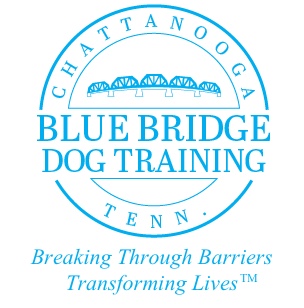Canine News You Can Use
Our Board & Train Programs... How exactly does that work?

Hey, what's going on here?
I sometimes get asked about what happens during a board and train program. Just as with people and how they interact on a team, your dog becomes part of my team, and we go through the stages of human-canine (interspecies, if you will) team development. The Forming–Storming–Norming–Performing model of group development for people was first proposed by Bruce Tuckman in 1965. So, let’s see how we’ve applied it to training your dog.
Phase 1: At Blue Bridge Dog Training
Forming Stage
I get to know your dog and your dog gets to know me. I once sat outside under a canopy while it was raining for an hour and a half with a new trainee because she was fearful and would not come near me. You do whatever it takes to earn the dog’s trust, or you simply cannot move through the process.
Storming Stage
I teach your dog is taught what is expected, but he doesn’t necessarily like it. Once we are past forming, I can begin to instruct your dog on what to do and not to do. Some dogs are extremely stubborn, and others not so much.
Norming Stage
Your dog and I come to an understanding of how our relationship is supposed to work. Your dog knows the commands and expected behavior, and although he might be pretty good at it, there is still work to be done to make it consistent.
Performing Stage
Your dog and I act as sort of a team. It’s like a quarterback calling the plays and the wide retriever… oops, receiver, running the correct routes. I’m happy, your dog is happy, and all is good.
Phase 2: Transforming (Back at your home)
Then the process starts again, but for you this time. That’s why the transition training (where you learn) is so important before your dog goes home. Equally important is the time you will need to spend with him/her at home. You will be working through the same stages that I did:
Forming... Your dog knows the old you, but now he will be adjusting to the new you, in your new leadership role.
Storming... Your dog knows what is expected, but he doesn’t necessarily like it coming from you. Be ready for the challenges, but be relentless, persistent, and consistent in your response.
Norming... Your dog and you come to an understanding of how your relationship is supposed to work, and your new expectations.
Performing... You and your dog act as a team. You are happy, your dog is happy, and life is good at home. What could be better than that?
Final Thoughts
Of course, we do not necessarily go through these stages exactly as I have described. Sometimes one is skipped, and sometimes we spend more time than usual in a stage. We can move back and forth between the same stages. There can be unexpected trouble spots that cause disruption or modification to the training. In the end, it is the team of you, me, and your dog that will make a training program successful.
Do you have comments or questions? Let us know on Facebook: Hey, what's going on here?
Automatically get notified of our blog updates and other stuff by signing up here: Subscribe Now (as a special bonus, you will also receive access to the “Wait Command Video” and a downloadable poster)
Breaking Through Barriers, Transforming Lives...
Jeff
